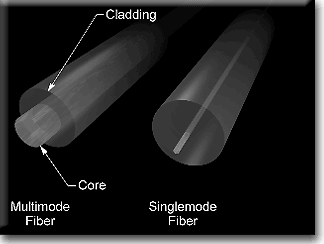Introduction to Fiber Optics
Light wave communication was first considered more than 100 years ago. the implementation of optical communication using lightwave guides was restricted to very short distances prior to 1970. Corn in g Glass company achieved a breakthrough in 1970 by producing a fuse dsilica(SiO) fiber with a loss of approximately 20dB/km. the development of semiconductor light sources also started to mature at about that time, allowing the feasibility of transmission over a few kilometers to be demonstrated. Since 1970, the rate of technological progress has been phenomenal, and optical fibers are now used in trans-oceanic service. Besides the long-distance routes, fibers are used in the inter CO( interexchange) routes, and the subscriber loop is the final link in what will eventually be the global interconnection chain . optical fibers are associated with high-capacity communications. A lot of attention is presently being given to optical fibers to provide a very extensive broadband ISDN.
Characteristics
The evolution of optical fibers has been extremely rapid over the past 20 years. Research and development have been directed toward reducing the signal attenuation of fibers, and also toward increasing the digital transmission rate through the fibers.Until the development of optical amplifiers, the attenuation defined the distance between regenerators, which directly affected the cost of an optical fiber route. Initial costs increase as the number of regenerators increases, so the regenerators pacing must be maximized. Note that in regenerators for optical fiber systems there is an optical -to- electrical conversion, complete regeneration of the pulse stream, retiming, and electrical back to conversion, ready for onward transmission. Maintenance costs also increase as the number of regenerators increases. Optical amplifiers do not entirely eliminate regenerators, but they do radically increase the distance between them. The transmission rate (bits per second) directly determines the number of channels the link can carry, so research has been aimed at maximizing parameter. The bit rate is dependent on the l inch e-width of the lightsource the size and dispersion characteristics of the fiber. Dispersion causes transmitted pulses to spread and over lap as they travel along a fiber, limiting the maximum transmission rate.
Ease of coupling light in to the fiber is also an important factor. This relates to the diameter of the light-carrying portion of the fiber and the characteristic of the glass wave guide.A parameter called the numerical aperture is associated with coupling.
Spectral width of the transmitting source.
The optical source does not emitan exact single frequency but is spread over a narrow band of frequencies. The laser has a narrower line width than the LED, and consequently is said to produce less in tramodal or chromatic dispersion than the LED. If the light sources could emit only one frequency, there would be no dispersion problem. Unfortunately, that is not possible.
The optical fiber causes dispersion, and the term chromatic dispersion is used to relate the spectral width of the source to the properties of the fiber. Chromatic dispersion is defined as the extent to which light pulses are spread for a specific source line width in an optical fiber due to the different group velocities of the different wave lengths within the source spectrum. the total chromatic dispersion is the sum of three components:
1.Modal dispersion
2.Material dispersion
3.Wave guide dispersion
Modal dispersion is dependent only on the fiber dimensions or, specifically, the core diameter.Single-mode fibers do not have modal dispersion. Multi-mode fibers suffer modal dispersion because each mode travels a different distance along a fiber and therefore has a different propagation time. This was the first type of fiber to be produced. Because the refractive index in the core is constant, the velocity of each mode is the same, so as the distance traveled by each mode differs from one to another, so does the propagation time. Because the light in these larger core fibers is composed of several hundred different modes, a pulse becomes broader as it travels along the fiber. The graded index profile causes the light rays toward the edge of the core to travel faster than those toward the center of the core. This effectively equalizes the transit times of the different modes, so they arrive at the receiver almost in phase. The graded index fiber pulse broadening (i.e.dispersion) is significantly improved over the step- index design.For multimode fiber, modal dispersion is a major limitation to high bit-rate performance. The single-mode fiber when operating in a truly single mode, has no other interfering rays, so it does not suffer modal dispersion pulse broadening. The single-mode fiber does, however, suffer from material and wave guide dispersion. This is because of the frequency dependence of the refractive index (and therefore the speed of light) for the fiber material. For silica, the total dispersion drops to zero at 1.31um.
Multi-mode fiber has a larger core diameter, which is the part of the wave guide carrying most of the signal strength( the remnant being carried in the cladding). This means that light signals entering one end of the fiber can reach the destination in a variety of ways: straight down the wave guide, though a series of reflections at the cladding interface, or in corkscrew fashion. The result is dispersion of the signal, spreading of the optical pulse in time. This limits the data rate or liquid band width.
Single-mode fiber, in contrast, has a core diameter (under10µm) which is small enough to prevent this & multi path effect. Sin gle-mode fiber is the type used in long haul telecommunications, such as in trans-oceanic telephone cables.
But is the tremendous band width of single-mode fiber really needed in underwater applications? The deepest point in the ocean is still a short haul from the surface in fiber optic terms. The answer to this question lies in the selection of the telemetry systems components, the most important one being the cable.

Single-mode vs. Multi-mode Fiber
It would appear that multi-mode fiber has an adequate bandwidth – distance produced to serve even the most demanding(Sub-sea and Land -based) requirements. A system having a 10,000 meter tether length can operate at 40MHz (or40Mbps) and still satisfy the 40MHz-km criteria.
The other key factor, however is attenuation. Single-mode fiber has lower attenuation then multi-mode fiber, as seen in table 1. But even here, the attenuation (signal loss) in multi-mode fiber is acceptable for many deep ocean systems, where in there is typically a flux budget of 18 or20 dB with standard low cost components. Why, then has single-mode fiber been chosen for some deep applications? The answer lies in its reduced susceptibility to micro bending losses.
Micro bending
Micro bending loss is the increase attenuation that occurs when the fiber is bent. For every fiber a critical angle within which the light will be reflected back with in the core and retained but beyond which it will be refracted out in to the cladding. It can be seen that local bending can increase this loss by increasing the angle. Single-mode fiber is intrinsically less prone to such losses than multi-mode as the light may be considered to be travelling purely axially.
The type of bending which most marine cables experience when wound over sheaves or outer drums does not in crease the loss significantly. Micro-bending loss is a smaller scale phenomenon reflecting the design of the cable. The optical fiber may be subjected to micro-bending when it is pressed against other cable elements due to external pressure. This effect, while very small, is cumulative over the cable length, and generally increases with pressure. A multi-mode fiber cable, to operate well in deep applications, must be designed to minimize micro-bending loss by providing for each fiber an environment that is free from localized bending. This can be achieved, at least in part, by the design of the plastic insulation surrounding the fibers, the choice of strength member (Kevlar -vs- steel) and its construction (braid -vs- parallel lay), the material between the fibers and strength member and other factors. The cable manufacturers can give advice and recommend designswhich have proven themselves.
<NEXT>
Providing a full range of services from Installation to repair to maintainence. We do it all at discount prices.
Check out our store for pricing information and to purchase.
If your business is located within the Tri-State area, our team of trained technicians can install, repair or maintain your phone system. Please contact us for a quote.
Whether you're moving a phone from one office to another, installing additional lines or phones, upgrading your phone system to have Voice Mail, or anything in between, the expert installers at Convergence Communications are here to help.

For existing systems we can help with programming on all levels. If you'd like to start a new auto-attendant campaign, re-configure your call flow, add users, delete users, enforce dialing restrictions, enact account codes and more, let us help put your plan in place.
We offer convenient 1-hour and 5-hour remote support options for you and your customers. Bulk purchases of 5-hours or more are discounted.
